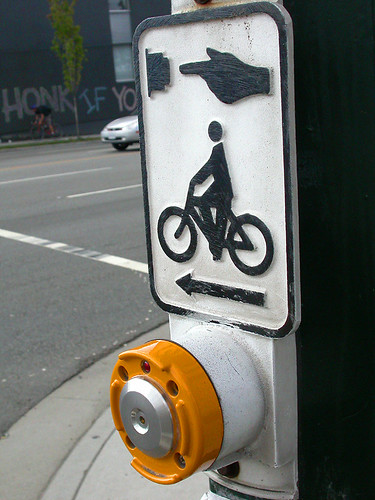
VANCOUVER — I’m lucky enough to have a decent bike to ride for the duration of my stay here on the west coast. I ride almost daily in Toronto but the experience of riding daily in Vancouver is much different — it’s not just the hilly terrain, but there seems to be an understanding from both city officials and drivers that cycling is a viable transportation alternative to the car. Riding through Vancouver produced not only aching leg muscles, but a self-diagnosed case of serious cyclist envy.
Vancouver does a number of smart and simple things to prioritize cycling that politicians and civil servants in Toronto should examine in detail. One of the first things I noticed: the cyclist symbol was included on the button to trigger an intersection stop light to change (photo above). Vancouver uses a pedestrian- and cyclist-controlled traffic light system throughout much of the city. In Toronto, you rarely ever see the fruits of your labour when you press the signal change button, but in Vancouver it is almost immediate (the longest I had to wait was about 10 seconds).
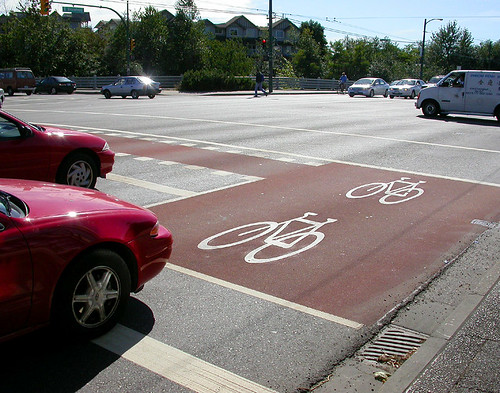
Cycling advocates like to use the phrase, “we are traffic!” when drivers accuse them of blocking their flow of traffic. To validate cyclists’ assertion that they are indeed part of the traffic club, Vancouver uses a bike waiting area at a few major intersections (photo above). It’s reminiscent of what happens at intersections in major Asian cities where scooters make their way to the front of the traffic queue. This type of waiting area is not used widely across the city and seems to be one of the improvements being made as part of the nearby (and massive) bikeway project called the Central Valley Greenway (I’m going to include the CVG in another post tomorrow).
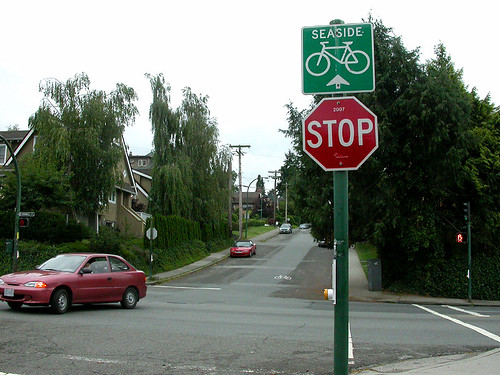
The other easily noticeable difference between our two cities is how bike lanes/routes are labelled: Vancouver uses a variety of indicators, most notably large signs with appropriate names (photo above), while in Toronto bike lane signs are tiny and have numeric names. Giving a route a numeric name works fine for highways, but for cycling routes it seems ridiculous to have the Davenport bike lanes called #18 and St. George Street bike lanes #35 — just call them the street name (or street names if they join up with other routes).
The other sign that cycling is a respected form of transit in Vancouver is how many of the street signs also include a bike symbol. Vancouver has roughly the same amount of dedicated bike lanes as Toronto, but it also designates many of it’s side streets as shared streets (which triples the size of its bike network compared to Toronto). The main streets are almost all devoid of bike lanes, but usually a street just one block away is a shared street that has traffic calming features that make cycling safe and quick. Vancouver is lucky to have a decent amount of continuous east-west and north-south streets that don’t deviate from the grid, making the shared lanes quite effective. As you can see, the street signs at smaller intersection (first photo below) indicate it’s shared street status while even the larger signs at main intersections (second photo below) alert drivers of their reduced status.
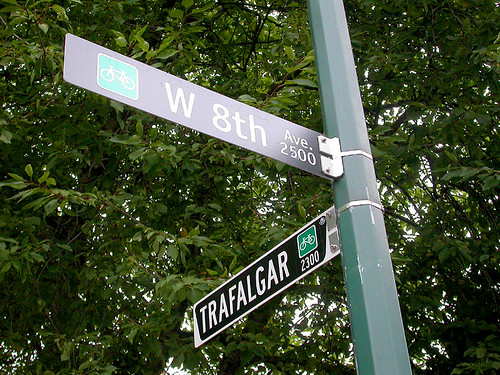

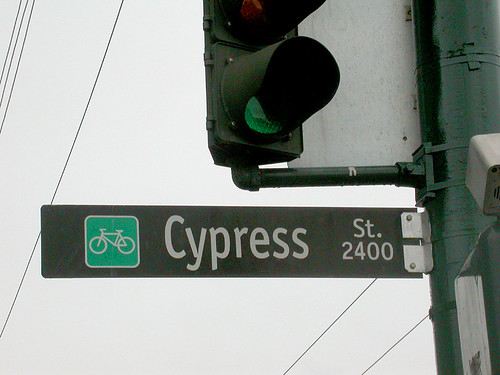
I also have a keen interest in bike racks: Vancouver offers up a variety of posts to lock your bike up to. A variety of racks is important so you don’t end up with a city-wide bike rack SNAFU like Toronto experienced last year (and is sadly still experiencing). And like the transit shelters and garbage bins across the city, the racks adhere to a local colour scheme.
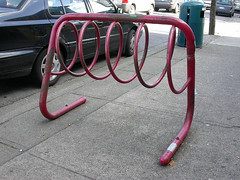

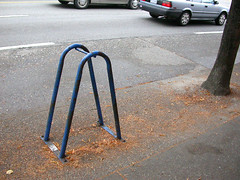

Tomorrow, I’ll share photos and observations on some of the traffic calming techniques Vancouver has recently put in place.
all photos by Matthew Blackett



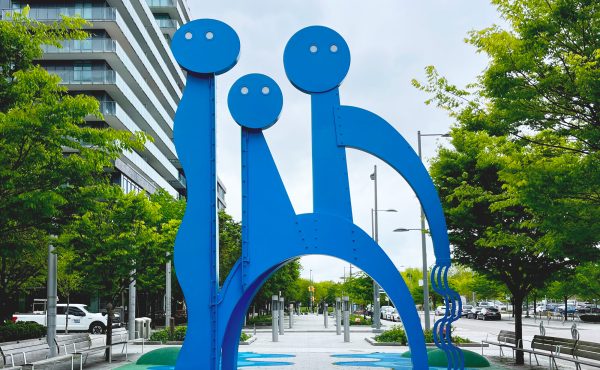
29 comments
Holy crap, it sucks here in Toronto!
I don’t think it sucks here — I just think Vancouver has set the bar high for North American cities.
Most of these features are relatively inexpensive. We just need flexibility from traffic engineers and the will of other civil servants and politicians. I know for certain Giambrone and Miller want this type of infrastructure, they just don’t seem to prioritize it.
I lived in Montreal for a while before coming back to Toronto and found they had a fairly decent bike culture as well. Even going to the extent of having special bicycle traffic lights.
I’d love to see them trial a bike waiting area and bike-only left-turn signal somewhere in TO, like College & St. George. A few of those at key intersections would make the city way more cyclist-friendly!
Those bike waiting areas are like the opposite of what I sometimes see (especially on College) where cars squeeze into the bike lane so they can try to make a right hand turn on a red.
Those bike waiting areas at intersections are sometimes called “bike boxes” or “advanced stop lines” (ASLs). The idea is to reduce conflicts by making cyclists more visible to motorists. It’s a pretty neat idea and it’s been around for over 2 decades (I think the Dutch came up with it?). Lots of cool research out there here and here.
It’s a been a few years since I was in Vancouver and they hadn’t installed any of them at the time. It’s great to see the city continues to raise the bar. Man, do I ever miss riding around Vancouver and Victoria!
Man, I didn’t realize you guys had it so bad (bike-wise) in Toronto. I love how bike-friendly my city is. Not only with the bike roads/lanes, but the motorists are generally pretty good too. The roads are shared and incidents seem to be rare.
And my thighs are RIPPED from riding up hills all day. 🙂
Having just moved to Toronto from Vancouver, where I lived for three years, I find there are *far* more people riding bikes throughout the city here. Certainly around and on the way to UBC there is significant bike traffic, but otherwise there is no comparison between the number of bikers here and there. I’m sure the more hilly nature of the city plays a role, but I haven’t figured out if there’s anything more to it than that.
The number one reason people stay away from biking in Toronto is safety. Safety, safety, safety.
Now imagine if Toronto provided a better range of cycling lanes…. This city is need of a massive increase i n bike infrastructure. Build it and they will come.
The best and cheapest thing the province could do for bicycle, and pedestrian, safety is to disallow right turns on red. Ontario drivers simply don’t deserve the priveledge, and I feel much safer negotiating intersection in Montreal and Quebec, where they don’t have it.
Michael, it does suck. Do you live and cycle here?
Another item that I liked better in Vancouver was their credit card sized fold-up bike map. Its size makes it convenient to carry around in your wallet all the time, ensuring that you have it on you when you actually need it.
Safety, safety, safety.
You got that right!
And it’s not just the bike lanes. It’s also the road rage, muggers stealing bikes while cyclists are still on them, bikes stolen while “securely” locked, and complete police indifference to cyclists. There is only one “program” at the city police to improve “improve safety”, and that the annual blitz that targets cyclists.
Just to talk a bit about what PhilipJ was saying, a couple of months ago, while riding on College St, I came to a light and there was a platoon of about 15 cyclists waiting for green! I’ve since noticed that this actually isn’t uncommon during rush hour. My supervisor said he did a quick count one day and the ratio of cars to cyclists was 2 to 1. That’s HUGE!
It certainly does feel like there are piles of riders in downtown Toronto. Unfortunately, it’s very hard to find reliable cyclist counts. It sounds simple enough but the exercise is fraught with methodological issues. TO’s a bigger and denser so I doubt the aggregate mode share is much different from Vancouver. I suspect that you’d find cycling well distributed across a wider region in Vancouver, whereas in Toronto, cycling seems more limited to the dense core. I could easily be wrong though.
More importantly though, I’d really like to know WHO is cycling in these two cities. The big problem with crappy bike facilities is that they tend to discourage the more vulnerable populations from riding. So you end up with just the healthy men pedaling around. I wonder if Vancouver, with its better facilities and bike-friendly culture, is having more success at reaching out to it’s entire population than Toronto?
Hey Dylan, I live in Little Italy and I see (and am one of the) many cyclists on College, and Harbord, every day. If the ratio is even close to what you say WHY THE HECK DO BICYCLES GET SQUEEZED OUT BY CARS? I mean, are vehicles citzens or are humans? Shouldn’t each person be entitled to the same amount of road space?
Matt, I made this comment on your Vancouver street furniture post, but I’ll make it here again. Another way that Vancouver caters to bikes is that most of the buses are equipped with racks. It’s really convenient for wimpy bike riders like me who don’t like to show up to work all sweaty but like to bike home. And the bus schedules on TransLink’s website lists which routes have bike racks, so you can plan your multi-modal trip to who knows where.
And to PhilipJ comment, if you look at Census data, a greater portion of the population in Vancouver bikes to work (1.9%) than compared to Toronto (0.8% 2001 values). However, with the differences in population, there’s roughly the same amount of bike commuters in each city (about 37,500 – if i did my math right). Regardless, since commuting by bike captures less than two percent of the mode share, there’s still much to do.
This is a very helpful post: the main post, pics and the comments. In many ways Toronto stinks, and we are behind many other parts of Canada, and the world.
For those with the tech; the Copenhagen City of Cyclists post is excellent.
http://video.google.com/videoplay?docid=-5092322980326147472
thanks to martino’s bikelanediary for the link.
And in the rush to be doing more for bikes with 2/3 less of a cycling cttee, we could be doing more of the same of politically easy patchworks of bike lanes and not putting them in where cyclists ride or would ride.
Repainting the streets for bike lanes is only $25,000 a km vs. $125,000,000/km for a certain road project.
Wow. I’m stunned. Wow. So brilliant, so simple. Let’s see the Toronto politicians claim they can’t do this because of being bankrupt when it is just a matter of symbols and attitude, not dollars. That’s the problem with Toronto – no vision. Way to go, big V.
alphabet, Exactly, that’s why I mentioned it. So many cyclists are dealing with road infrastructure that doesn’t address their needs. As Matt said, imagine how many more would ride if we had good facilities!
Amanda, I always take that census data with a big grain of salt 😉 But you’re right, anyway you cut it, the bike mode share is nowhere near its potential.
While we’re on the topic of bike infrastructure, has anyone seen the car parking spots converted to bike parking in Montreal? So cool. It’d post a picture if I could….
You can see more photos of cycling infrastructure from other cities on Spacing’s Flickr account (pics are by Spacing editors).
I’ll do it for you, Dylan.
here’s Montreal’s:
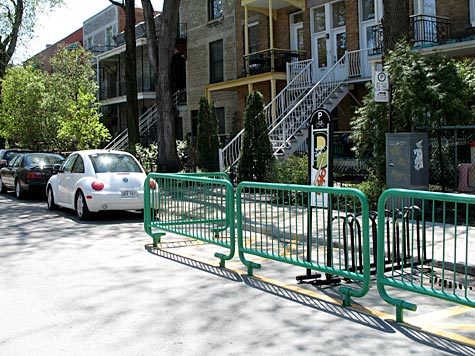
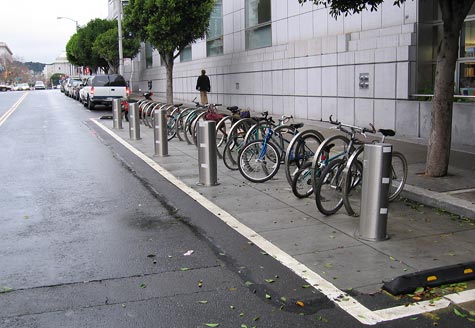
And here’s one from San Francisco:
Visiting Vancouver this summer I was impressed by many of the bike-friendly features that you mentioned. But saw very few cyclists actually taking advantage of them. Other than along the seawall, cyclists weren’t very prominant at all.
Another big difference that I noticed were bike locks. In Toronto there are New York and Stock locks all over. I didn’t see a single lock even approaching that quality in Vancouver.
Very cool, Matt. Thanks for this. For Toronto’s bikeway network route signs, sure, we could use street names — but why not actually name the bikeways? …maybe after local a/or famous people, like we do with some parks for ex. It would be fun and make for wider recognition of the infrastructure, I think. Oh, and definitely make the signs bigger and more akin to the signs for motorists! Yes please!
I would LOVE to see a bike waiting box on College at Bathurst or Spadina. I’m laughing thinking of all the excuses that would come in opposition to that idea tho! Perhaps the Other Urban Repair Squad(s) can add this design idea and some red paint to their palettes?
I look forward to the traffic calming post. my new mantra when yelling at, er, conducting on-the-spot “motorist information sessions” is: SLOW DOWN!
@ DylanP: “I wonder if Vancouver, with its better facilities and bike-friendly culture, is having more success at reaching out to it’s entire population than Toronto?”
This is just my own personal view of what I see when I ride around, but I’d say the split is almost 50/50 of men and women. Pretty mixed.
Any other Vancouverites see different?
I live here in Vancouver, and although it may seem far better than Toronto for cyclists, we still have a long way to go. They have been making baby steps and its getting better, although the ultimate riding city is Copenhagen Denmark. Entire lanes on every street for bikes only, and cyclists own traffic lights are just a couple of the great features they have there.
I LOVE TT’s suggestion:
“For Toronto’s bikeway network route signs, sure, we could use street names  but why not actually name the bikeways? …maybe after local a/or famous people, like we do with some parks for ex.”
Much as I generally dislike the naming of schools/airports/roads/parks after politicians (especially those still alive), I would endorse such naming, if said person were to actually support/endorse the bike infrastructure.
I propose calling the future route on Donlands Avenue from the Leaside bridge to Danforth the “Case Ootes Bikeway”.
Vancouver is pretty great for biking. After moving here it took a lot of getting used to the hills, though. I bike to work almost every day and there is a lot of happy bike traffic on the east/west shared bike/car sidestreet I use. However, there is almost nowhere to lock up. A few streets have installations like the ones depicted, but there are too few on those streets, and plenty of streets have little or no locks at all — I use parking metres usually (where post and rings came from to start with anyway, I think).
There is also the problem of “bike lanes” downtown which are actually the HOV lanes shared with speeding buses and taxis. They can be pretty scary. And the bridges are pretty scary for cyclists too. The sidewalks are narrow, shared with pedestrians (with a lane painted usually for cyclists and pretty good signage, mind you), but still, you often feel like one wrong move and you’ll fall of the really high curb into the highway-speed car traffic.
Still, though, biking here is a real pleasure and you get the sense that cycling MATTERS as a form of transportation here.
And I notice a real gender mix among cyclists, too. A fair number of white faces, though, maybe out of proportion to their population share. I have the feeling that people of colour are under-represented among cyclists.
This is something I came across about a fantasy multi-mode transit avenue in LA: subway, bus and bikes. Read it, it sounds cool: http://www.cicle.org/cicle_content/pivot/entry.php?id=1456 It ought to work in LA where weather lets you ride year round. We have eight good months of cycling in Toronto, and twelve months for the serious.
As for Toronto, something like this could work on Queen (streetcars and bikes, no cars) and/or on Bloor (no motorized transport above ground at all, and wider sidewalks). While I am in fantasy land and lord of the universe, I would block all side streets and only allow cross-traffic at major intersections, such as on Bloor where the subway stations are. Won’t happen, but this ought to be done on Queen from Roncesvalles to Woodbine, and on Bloor from Lansdowne to Sherbourne.
My other fantasy is to shunt the waterfront trail across the Islands if the airport gets closed. N/S route? With a subway underneath, does Avenue really need six lanes? Any other street near a N/S subway (i.e. Yonge/Bay) is too narrow or discontinuous.
Fewer people cycle than would if they felt safer, study after study affirms. Give them a place, and get the cops to wake up on ticketing bad (rather than fast) driving would achieve safety, would achieve more cyclists. The three road routes (Queen, Bloor, Avenue) could be implemented on a trial basis in the summer. Far more meaningful than ‘Quay to the City’: https://spacing.ca/toronto/?p=1024 The Island Airport, Porter Airlines and the Port Authority all have to be killed for the waterfront route.
Route Maps:
Queen, 11.8km http://www.bikely.com/maps/bike-path/Queen-Roncessvalles-to-Woodbine
Bloor, 5.6km http://www.bikely.com/maps/bike-path/Bloor-Lansdowne-to-Sherbourne
Avenue, 2.2km http://www.bikely.com/maps/bike-path/Avenue-Queen-to-Bloor
Waterfront, 8km http://www.bikely.com/maps/bike-path/Waterfront-via-Islands
[…] guy from Toronto wrote a much more informative article on Vancouver’s Bike infrastructure here. I might as well chime in with what I think are some key points to realize when biking or preparing […]
I’ve lived in Toronto (great nightlife, funky neighbourhoods and cottage country) and I now live in Vancouver. Vancouver does set the bar high for walking and bicycle-based commuting. Particularly if live downtown, the West End, False Creek, Yaletown and Kitsilano, this place is a bicyclist’s dream (these areas also have the priciest real estate). That’s not to mention the world-renowned free-ride mountain biking in North Vancouver.
It is a differently story for bicycling if you live in one of the out-lying and congested suburbs of Vancouver though (going over major bridges in this city is fun!). There’s more info on self-propelled transport in Vancouver here:
http://www.keepitsurreal.net/index.php?/vancouver/walk-bicycle-vancouver